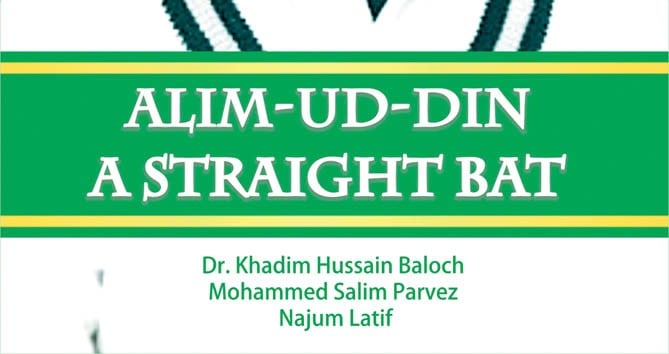
Alim ud-Din was in the Pakistan team which gained their epic, series-levelling win against England at the Oval in their inaugural tour in 1954

The opening batsman Alim ud-Din was one of the mainstays of Pakistan after its emergence into Test status. His chance came in bizarre circumstances: the established opener, Nazar Mohammad (father of the future star Mudassar Nazar) broke his arm beyond repair after jumping from a window, almost certainly escaping from a jealous husband.
Alim ud-Din played 25 Tests for Pakistan from 1954 to 1962, with two centuries (against England and India), scoring 1091 runs at an average of 25.37, most of them as opener in partnership with the great Hanif Mohammad. The figures do not look outstanding but he was deeply respected by all his colleagues, particularly Hanif, and Pakistan were twice as successful in the Tests they played with him in those years than in the 17 they played without him. He was widely regarded as the straightest bat in Pakistan, with a calm, correct technique against all but the very fastest bowlers.
Alim ud-Din was in the Pakistan team which gained their epic, series-levelling win against England at the Oval in their inaugural tour in 1954. In truth, he had a poor match - stumps shattered for 10 in the first innings by the electrically fast Frank Tyson, demoted to the middle order in the second and lbw without scoring to the aggressive left-arm spin of Johnny Wardle. Worse still, he dropped Wardle at second slip in England’s second innings as they closed in on their meagre victory target -- an agonizing lapse for one of Pakistan’s best fielders. In misery, he begged Fazal Mahmood to dismiss Wardle and save him from a lynching from Pakistan’s supporters. Fortunately Fazal obliged, and with the help of other fielders, Pakistan removed the remaining English batsmen. Alim ud-Din could thereby enjoy the status of a national hero for the remainder of his life.
Alim ud-Din’s Tests were part of a first-class career which began at an astonishingly early age and spanned 26 years, initially in pre-partition India and then in Pakistan. No fewer than three of Pakistan’s leading cricket historians have collaborated on a new biography of him: Alim ud-Din A Straight Bat (Jumhoori Publications, Lahore). It is not a conventional biography: each one looks at Alim ud-Din from a different perspective. Dr Khadim Hussain Baloch assesses his career in its historic context, within the structures and social milieus which shaped early Pakistan cricket, Najum Latif contributes personal memories of a long friendship with Alim ud-Din, and Mohammad Salim Parvez traces his career season by season.
This method means that many details are repeated, but it also allows the reader to appreciate their significance, as for example when Dr Baloch points out that Alim ud-Din "became the first Pakistani to play a ball as a Pakistani", as opener for Sind against the touring West Indians in 1948-49. (He was caught behind off Gerry Gomez for 6 in the first innings but had a long innings of 45 in the second which helped to save the match.) There is also a delightful anecdote by Najum Latif which illustrates the financial conditions faced by Pakistan’s early cricketers. Alim ud-Din, despite several years as Test opener, was in perpetual debt to his milkman. He was selected for the tour of West Indies in 1957-58 and the milkman asked for his money. Alim ud-Din told him he would have to wait: the players would not get paid anything until they actually performed on the tour.
Largely from Alim ud-Din’s own memories, the book uncovers his early life, in a family the size of a cricket team, the second of eleven children of an electrical engineer in the town of Ajmer, in Rajputana in pre-partitition India. He showed precocious talent, which caught the eye of several local princes and earned him admission to the lavish cricket facilities at Mayo College, often called the Eton of India. Most importantly, the authors support Alim-ud-Din’s stated birthdate of 15 December 1930 - which makes him the youngest person to play first-class cricket, aged just 12 years and 73 days on debut for Rajputana in the Ranji Trophy. They were a weak side who went down to a massive defeat against Baroda, but the boy was top scorer with 13 in the first innings of 54, and second top scorer with 27, out of 133, in the second. His seldom-used flighty leg-spin had a mighty first victim - the great Vijay Hazare.
As a teenager he gravitated to the more powerful Gujerat side in Bombay, before his family had to flee their home in Ajmer on the eve of partition when attacked by knife-wielding Sikhs. Alim ud-Din re-established himself quickly in Karachi and was still only 17 when he received that historic first delivery by a Pakistani against the West Indians.
Pakistan cricket biographies are often reticent about personal matters, but this one is lightened by details which show why Alim ud-Din was popular with colleagues and crowds. He was invariably dapper, even dandyish, on and off the field. Although he never married, because he supported his extended family, he was a ladies’ man, ever ready with chat-up lines. He was a fine singer, whose performances enlivened all his tours and even warmed his normally stern captain, A H Kardar.
Alim ud-Din deserved this biography, which adds another rich thread to the tapestry of Pakistan cricket.